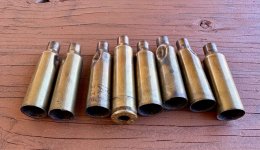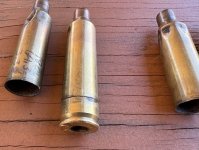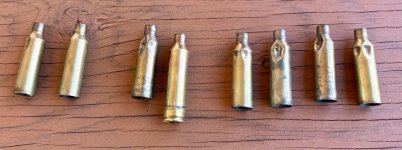Interesting (and confusing) find in the brass pail at the range. I’m not sure I can explain what I’m seeing but maybe someone here can.
Approximately 20 rounds of reloaded 7PRC (some cases were marked with felt pen with the load recipe) were found in the brass pail. I couldn’t read all the writing on the cases but I read 175gr ELD-X and 180 gr M. The powder charges read 64.3, 64.0 (or possibly 69.0), 69.5 and 70.0gr. I couldn’t see powder type. One case was found with Fierce written on it. I presume that might be the rifle they were shot from.
All cases looked to be fired…based on the soot marks. All but 2 rounds had complete head separations and the 2 that weren’t separated were literally hanging on by a thread. All rounds, including the 2 unseperated, have severe “dents” in the case near the body/shoulder junction. The two remaining case heads had severe pressure signs (one missing a primer the other flattened real bad). Also both remaining heads had brass flow into the ejector hole. I didn’t find any of the separated heads. The only case heads I found were the two attached.
It certainly appears like the rounds were fired and were severely over pressured. Maybe a bad head spacing issue?/
All dents are smooth on the surface like they might be caused by hydraulic pressure from the outside. I’ve been reloading for many years but never experienced case head separation. Could those dents be caused by gas from the separated case head getting trapped between the case and the bolt/action. Then, once the pressure inside the case dissipated, the case collapsed.
What else could cause the denting?
Assuming all the brass failed during firing…
How would someone eject those failed rounds?
I wonder what the bolt and action of the rifle would look like after this kind of abuse!
I wonder what the experience level/IQ of the shooter/reloader might be?
Again, I can see one case head failure, maybe two…but 20…it seems inconceivable!
Approximately 20 rounds of reloaded 7PRC (some cases were marked with felt pen with the load recipe) were found in the brass pail. I couldn’t read all the writing on the cases but I read 175gr ELD-X and 180 gr M. The powder charges read 64.3, 64.0 (or possibly 69.0), 69.5 and 70.0gr. I couldn’t see powder type. One case was found with Fierce written on it. I presume that might be the rifle they were shot from.
All cases looked to be fired…based on the soot marks. All but 2 rounds had complete head separations and the 2 that weren’t separated were literally hanging on by a thread. All rounds, including the 2 unseperated, have severe “dents” in the case near the body/shoulder junction. The two remaining case heads had severe pressure signs (one missing a primer the other flattened real bad). Also both remaining heads had brass flow into the ejector hole. I didn’t find any of the separated heads. The only case heads I found were the two attached.
It certainly appears like the rounds were fired and were severely over pressured. Maybe a bad head spacing issue?/
All dents are smooth on the surface like they might be caused by hydraulic pressure from the outside. I’ve been reloading for many years but never experienced case head separation. Could those dents be caused by gas from the separated case head getting trapped between the case and the bolt/action. Then, once the pressure inside the case dissipated, the case collapsed.
What else could cause the denting?
Assuming all the brass failed during firing…
How would someone eject those failed rounds?
I wonder what the bolt and action of the rifle would look like after this kind of abuse!
I wonder what the experience level/IQ of the shooter/reloader might be?
Again, I can see one case head failure, maybe two…but 20…it seems inconceivable!
Attachments
Last edited:









































































